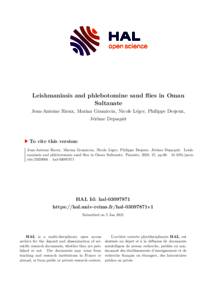وثيقة
Leishmaniasis and phlebotomine sand flies in Oman Sultanate.
المعرف
DOI: 10.1051/parasite/2020064
المصدر
Parasite. v. 27, 200118
المساهمون
الدولة
France
الناشر
EDP Sciences.
ميلادي
2020-01-01
اللغة
الأنجليزية
الملخص الإنجليزي
There are few data on leishmaniases and sandflies in Oman Sultanate. We carried out an eco-epidemiological study in 1998 in the two main mountains of the country, the Sharqiyah and the Dhofar. This study allowed us to isolate and identify three Leishmania strains from patients exhibiting cutaneous leishmaniasis. The typing carried out by isoenzymatic study and by molecular biology were congruent: two strains of Leishmania donovani zymodeme (Z) MON-31 isolated in the Sharqiyah and one L. tropica ZROM102 (ZMON-39 variant for 4 isoenzymes) from the Dhofar. No strain was isolated from canids. The study of sandflies identified 14 species distributed in the genera Phlebotomus, Sergentomyia and Grassomyia: Ph. papatasi, Ph. bergeroti, Ph. duboscqi, Ph. alexandri, Ph. saevus, Ph. sergenti, Se. fallax, Se. baghdadis, Se. cincta, Se. christophersi, Se. clydei, Se. tiberiadis, Se. africana, and Gr. dreyfussi. In Sharqiyah, the only candidate for the transmission of L. donovani was Ph. alexandri, but the low densities observed of this species do not argue in favor of any role. In Dhofar, Ph. sergenti is the most important proven vector of L. tropica, but Ph. saevus, a locally much more abundant species, constitutes a good candidate for transmission.
ISSN
1252-607X
URL المصدر
قالب العنصر
مقالات الدوريات


